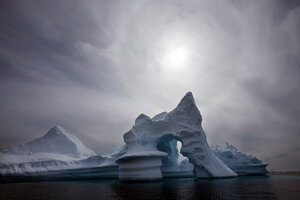Greenland ice: Less vulnerable to climate change than feared
Fluctuations in ice melting over time in Greenland may mean that the trajectory towards a complete melt is less direct than previously thought. New research suggests that future sea level rise predictions should be made cautiously.

An iceberg melts off Ammassalik Island in Eastern Greenland in this file photo. Melting in Greenland may ebb and flow more than researchers realized.
AP Photo/John McConnico, file
OSLO
Greenland's ice seems less vulnerable than feared to a runaway melt that would drive up world sea levels, according to a study showing that a surge of ice loss had petered out."
It is too early to proclaim the 'ice sheet's future doom'" caused by climate change, lead author Kurt Kjaer of the University of Copenhagen wrote in a statement of the findings in Friday's edition of the journal Science.
An examination of old photos taken from planes revealed a sharp thinning of glaciers in north-west Greenland from 1985 to 1993, the experts in Denmark, Britain and the Netherlands wrote. Another pulse of ice loss in the area lasted from 2005 to 2010.
The discovery of fluctuations casts doubt on projections that Greenland could be headed for an unstoppable meltdown, triggered by manmade global warming. Greenland contains enough ice to raise sea levels by 7 metres (23 ft) if it all thawed.
"It starts and then it stops," Kjaer told Reuters of the ice losses. "This is a break from thinking that it is something that starts, accelerates and will consume Greenland all at once."
However, Kjaer noted that the ice sheet did not get bigger in the pause between the pulses of ice loss.
He said satellite data of Greenland's ice only dated back to about 2000 and the use of aerial photos had extended the records of the remote Arctic region back another 15 years.
The cause of the surge in ice loss in the 1980s was unclear but might have been linked to a shift in ocean currents. The underlying cause of a change in currents was unknown.
NASA said last month that almost the entire surface of Greenland had been thawing in a rare warm spell that it said might happen only once every 150 years.
And an iceberg twice the size of Manhattan recently broke off the Petermann glacier, to the north of the area studied by Kjaer's team.
Lack of historical data is a problem for climate scientists studying Greenland and the far bigger Antarctic ice sheet, which would raise sea levels by about 60 metres if it ever all melted.
The U.N. panel of climate scientists says manmade emissions of greenhouse gases, mainly from burning fossil fuels, will cause ever more floods, droughts, heatwaves and rising seas.
It projected in 2007 that sea levels could rise by 18-59 cms by 2100. Many experts since then have projected bigger rises and U.N. Secretary-General Ban Ki-moon once said seas could gain up to 2 metres this century in the worst case.
Kjaer said experts would have to be cautious in projecting an acceleration of sea level rise, now at a rate of about 3 mm a year or 30 cms over a century. Sea level rise is a threat to people from New York to London, from Bangladesh to Kiribati.
The Danish-led team of scientists also published data in May indicating that ice in the south-east of Greenland had shrunk in a previous warming period in the 1930s.
They now had a database of 160,000 photos of Greenland, including U.S. surveys in the 1940s. "That's something to be working with," Kjaer said.
(Editing by Janet Lawrence)

